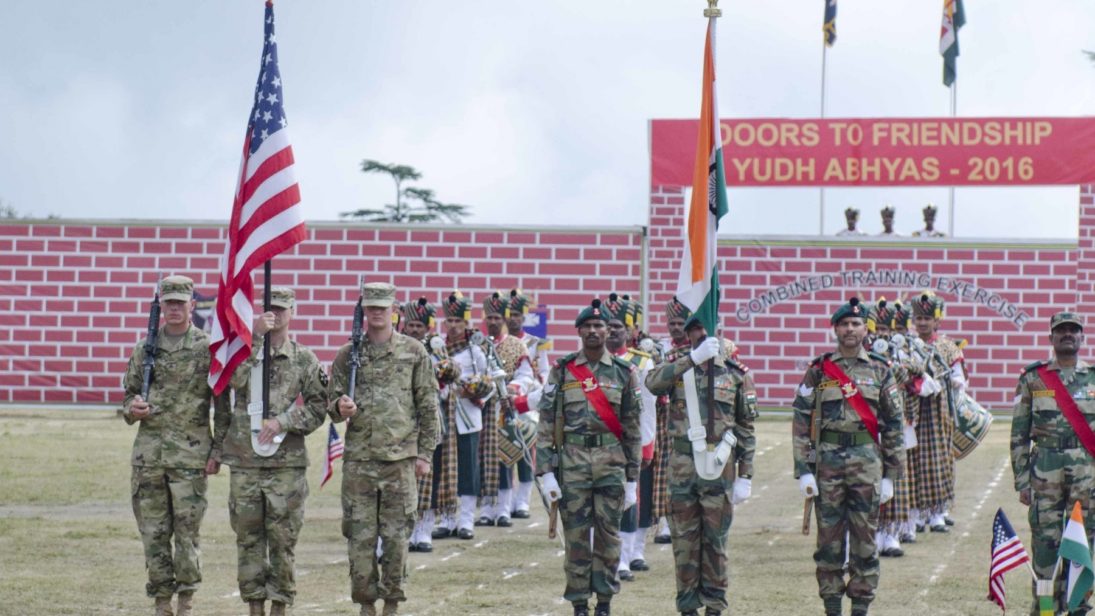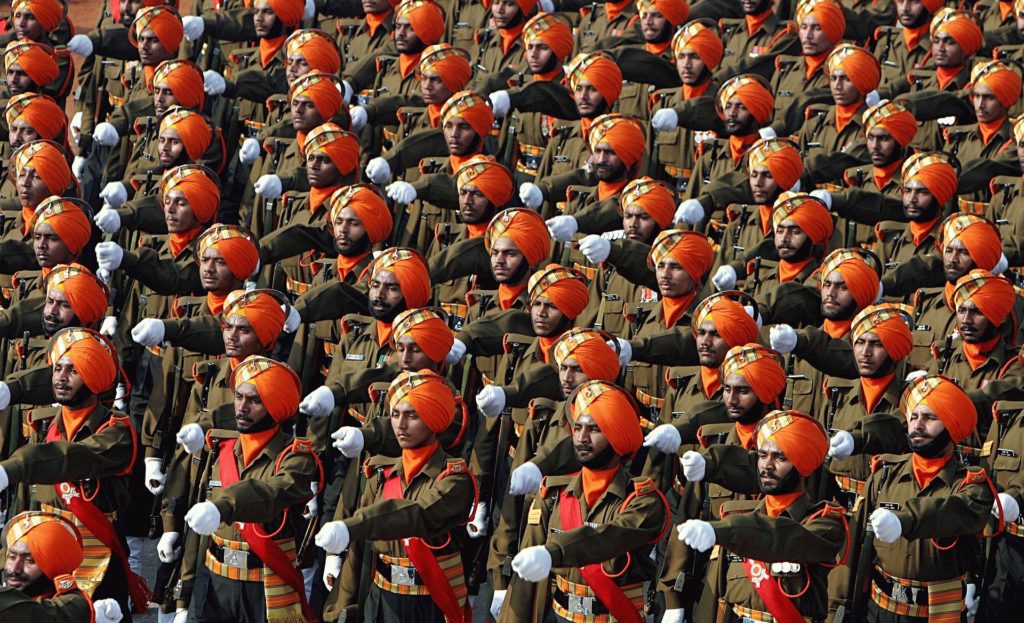
The American national security bureaucracy has invested tremendously in India in recent times. Designating India as a “major defense partner” in 2016, then-defense secretary Ashton Carter noted this would allow “the United States and India to cooperate…in a way that we do only with our closest and most long-standing allies.” India’s prominence in the latest National Security Strategy, the rechristening of the U.S. Pacific Command as the Indo-Pacific Command, as well as two new U.S.-India military agreements all reflect the Pentagon’s hope that a rising India will be a natural counterweight to a revisionist China.
And the Pentagon does have a point. India’s economy will soon be larger than that of the United Kingdom. Relative to China, India’s demographic profile is better poised to sustain economic growth. Its military expenditure is the fifth largest in the world and the country is now closer to acquiring a functional nuclear triad.
That said, India’s national security policies contain unresolved dilemmas that create challenges for both its posture and what the country can do with—and for—the United States. Five themes emerge upon a closer look at India’s defense policy: a persistent mismatch between India’s capability and threat environment; a small military-industrial ecosystem that affects domestic defense production; blurred lines between internal and external security priorities; weak coordination structures; and finally, poor communication and signaling strategies.
Mismatch Between Capability and Threat Environment
India’s external security environment is unique in that it faces two geographically contiguous nuclear-armed adversaries, China and Pakistan. India’s disputed land borders with both only exacerbate this significant security challenge. To meet these challenges, in budget year 2018-19 India’s defense budget was a meager 1.49 percent of the country’s gross domestic product (GDP). And much of that does little to improve capability. India spends more money on ex-military personnel than it does on acquiring new weapons. In budget year 2018-19, salaries and pensions consumed 54.5 percent of total defense spending, while new weapons accounted for only 18 percent. In comparison, over roughly the same period, the U.S. Department of Defense allocated about 22.8 percent of its budget to military personnel costs. The result has been a steady relative decline of India’s military capabilities against that of China’s and Pakistan’s put together over the last decade.
The United States might have to reconsider its two-decades-old assumption that a strong India will help protect American hegemony by serving as a countervailing weight to China. If India’s defense capabilities continue to fall behind that of China’s, a disappointed Washington might lose interest in India.
Budgetary pathologies also shape India’s military outlook and readiness. The army’s share of the defense budget is the highest among the services and the navy’s remains the smallest; laconic analysts have termed the Indian navy the “Cinderella service.” Consequently, India’s ability to project power remains limited and the country’s commitment to a “free and open Indo-Pacific” is largely rhetorical. Within the army’s budgetary allocations, the share of manpower expenditure is overwhelmingly spent on new weapons, spare parts, and stockpiles. In 2018, the auditor noted that 40 percent of India’s ammunition stock would not last for more than ten days of warfare. However, the budgetary tilt towards the army’s manpower is unlikely to be corrected soon for electoral reasons. As one example, Uttar Pradesh, “the highest-represented state in current [2009 data] army recruitment” also makes up for almost 16 percent of all seats in the lower house of India’s parliament. Any dramatic attempt to right-size the Indian Army will be politically very expensive.
Small Military Industrial Ecosystem
An ineffective indigenous defense manufacturing and research & development base is another serious weakness. India is the world’s largest defense importer. Moreover, it is highly dependent on a single source–in the years 2013-2017, 62 percent of India’s defense imports came from Russia alone. (In comparison, during the same period, the United States accounted for 15 percent of India’s weapons imports.) Rarely have countries aspiring to become “leading powers” depended on others for their arms. India’s reliance on foreign (especially Russian) arms complicates its foreign policy. Yet any attempt to dramatically reduce Indian dependence on Russian weaponry will likely meet stiff opposition within the government given the illogical yet abiding view that deep relations with Russia contribute to India’s “strategic autonomy.”
Despite early promises by the current Modi government to build a domestic defense-industrial base for both internal consumption and export, foreign investment in India’s private defense sector remains meagre. The country’s elusive quest to domestically manufacture medium multi-role combat aircraft (potentially with foreign partners) at a time when the Indian Air Force’s squadron strength is at its lowest in over a decade illustrates this weakness and its consequences. Nonetheless, persistent political controversies deter domestic firms from entering the defense manufacturing market.
A related lacuna in India’s defense posture is a weak military research and development ecosystem. India’s research is mostly concentrated in the state-run Defense Research & Development Organization (DRDO), a lumbering behemoth with 50 laboratories under its control. A legacy of India’s past as a centrally-planned economy, the DRDO has “persistently over-promised and under-delivered.” Bureaucratic rigidity continues to impede greater involvement of non-government organizations in defense research and development. While India’s military leadership has highlighted the need to leverage next-generation technologies such as artificial intelligence and big data, the country has yet to create a DARPA-style agency to develop the innovative, asymmetric capabilities required to compete with China. Even India’s closest defense partners—Russia, the United States, and Israel—are unlikely to share closely held technology. Therefore, unless the country’s political establishment finds a way to channel India’s strong civilian scientific and technical base towards defense innovation, the country is almost certain to fall behind China, which has managed to do so.

Blurred Lines Between Internal and External Security
A further complication in India’s defense policy is the blurred line between the country’s internal and external security. A product of disputed borders with Pakistan (and to a lesser extent, China), multiple insurgencies—especially in Indian-administered Kashmir—continue to sap military resources and shape priorities. Terrorist attacks in the country emanating from Pakistan, such as the horrific 2008 attack in Mumbai, have caused India to simultaneously attempt to deal with terrorism, insurgency, and external threats. Each of these objectives demand distinct resources and force structures, straining India’s already limited national security budget.
The Indian government’s extensive focus on counterterrorism and counterinsurgency continues to shape the security bureaucracy as well as military doctrines. First, in 2016, Prime Minister Modi ignored customary practice for high-level appointments to appoint Lieutenant General Bipin Rawat as India’s army chief. As a former deputy chief of the Indian army wrote at that time, Rawat’s reputation as a counterinsurgency expert led to his selection over other candidates. Second, the blurring of external and internal security has also meant that two of the five Indian national security advisors to date have been former chiefs of the domestic intelligence service. It is difficult to imagine a similar trend between the directors of the Federal Bureau of Investigation and the National Security Council in the U.S. system. Finally, the Indian Army’s 2019 Land Warfare Doctrine reflects an ongoing preoccupation with “hybrid war” in Kashmir.
Interestingly, this blurring of domestic and external security has not translated to national security coming to the forefront as an important issue in Indian domestic politics, save for occasional election-time rhetoric around Pakistan and Kashmir. But as new research demonstrates, Indian politicians have little electoral incentive to promote defense and foreign policy goals that are considered a part of elite rather than mass politics.
Weak Coordination Structures
India continues to lack effective coordination mechanisms to promote jointness and interoperability among the three armed services. The foremost example of this problem is the lack of a chief of defense staff (CDS), akin to the American Chairman of the Joint Chiefs of Staff. While successive government committees have highlighted the need for a single point of military advice to the political leadership—and the Modi government expressed an early interest in creating such a position—persistent patterns of civil-military relations have prevented action. Absent an appointed CDS, the existing Integrated Defense Staff Headquarters (headed by a rotating Chairman of Chiefs of Staff Committee) is a largely ineffective institution.
The lack of jointness within the Indian military, a function of weak inter-service coordination structures, limits the achievable level of interoperability between the militaries of the United States and India.
The lack of a formal unified defense management structure has given greater power to the office of the prime minister, skewing civil-military relations. Decisions on India’s key national security matters have always rested with the prime minister and a close circle of advisors, a more centralized power structure than in the United States. For example, India’s military decisions in the run-up to its disastrous clash with China in 1962 were mostly taken by then Prime Minister Jawaharlal Nehru and his defense minister (neither of whom had any military experience) along with a few army officers. Prime Minister Modi’s 2018 defense reforms proposals have reinforced this pattern, by empowering the civilian national security advisor to act as a “de-facto CDS.”
Poor Strategic Communications and Signaling
While strategic communications and signaling are sometimes an afterthought of a nation’s defense posture, they are critical elements within democracies. While the Indian polity at large is capable of calibrating its strategic communications in moments of crisis—the Indian media’s collective restraint during the 2017 India-China standoff being a case in point—the Indian government’s failure to produce a public national security strategy (NSS), despite three past attempts, is a lost opportunity to sensitize the public to national security goals, justify defense spending, and reassure international partners through an articulation of India’s long-term strategic commitments.
But whether this is as much due to bureaucratic indifference as it is a manifestation of India’s long-standing posture of strategic autonomy and ambiguity – of treating all partners on an even keel without revealing any preference – can be debated. What is clear is the damage the absence of such a document has done to the overall defense planning process. For one, when India released a Joint Doctrine of the Indian Armed Forces in 2017, it quickly became clear that it did not flow from any top-level politically-sanctioned strategy document. Instead it became, as observers noted, a substitute for it. This would have been almost palatable had the doctrine not imposed an army-centric posture on the three services and neglected force projection questions – without political clearance.
In the absence of clear policy statements, observers are forced to parse through often elliptical writings by former government officials for clues as to India’s strategic direction. The on-going debate about India’s commitment to a nuclear no first use posture is a case in point. While India remains the only country in the world with a publicly-available written nuclear doctrine that spells out the circumstances under which it might use nuclear weapons, that document is widely seen as incredible by many experts. Contradictory off-the-cuff remarks from a serving defense minister only raised the already serious doubts about India’s no first use pledge. The apparently unintentional confusion surrounding India’s nuclear posture illustrates how much improvement is required in its strategic signaling.
Implications for the United States
These five persistent problems with India’s defense policy have three implications for the United States. First, the United States might have to reconsider its two-decades-old assumption that a strong India will help protect American hegemony by serving as a countervailing weight to China. If India’s defense capabilities continue to fall behind that of China’s, a disappointed Washington might lose interest in India. Second, the lack of jointness within the Indian military, a function of weak inter-service coordination structures, limits the achievable level of interoperability between the militaries of the United States and India. The Indian military would face serious difficulties if required to coordinate joint force operations with American forces in a contingency. Finally, absent a public Indian strategy document that commits the country to certain objectives, there will be lingering suspicions inside the Pentagon and elsewhere about the overall direction of India’s grand strategy and the United States place in it.
Editor’s Note: A version of this piece originally appeared in WAR ROOM, the online journal of the U.S. Army War College, and has been republished with permission from the editors.
***
Image 1: U.S. Indo-Pacific Command via Flickr
Image 2: Antônio Milena via Wikimedia Commons


